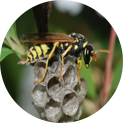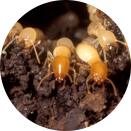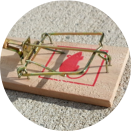Where to start with pest control
1.800.858.7378npic@oregonstate.edu
We're open from 8:00AM to 12:00PM Pacific Time, Mon-Fri
A to Z

Pests are unwanted plants, animals, insects, germs or other organisms that interfere with human activity. They may bite, destroy food crops, damage property, or otherwise make our lives more difficult.
NPIC does not make recommendations. But, we can certainly shed some light on the path to effective pest control.
- I'm uncertain where to start
- Identifying the pest
- Learning about MY pest (ants, bedbugs, wasps, etc.)
- Knowing when to take action
- Exploring effective control methods
- Gauging my pest control success
 |
Are you UNCERTAIN where to start in the pest control process? Determine if the problem is something you can tackle or if help from a pro is needed. Maybe you're the type to dive in, research your pest, explore the most effective control options, and are feeling well prepared to take things on by yourself. Or maybe you feel like you are in over your head, don't have time to learn about your pest, or can't get access to the tools you need to do the job well. Whether you've "got this" or need a pro, there are resources available to you. Who can help if I do this myself?
Who can help if I need a pro?
|
 |
Step 1: Properly identify your pest. It's much harder and much less effective to battle your pest if you don't know exactly what it is. Who can help? |
 |
Step 2: Find out more about your pest's habits. Learn why it's there in the first place. What does it need in order to survive? Might it cause harm to people, animals, buildings, and such? What makes it grow, develop, and reproduce? Knowing this information highlights a pest's weaknesses, which you can use to your advantage (puts you in control of the situation). Who can help?
|
 |
Step 3: Decide whether action is needed...or whether you can tolerate the pest's presence for now. If a pest is known to transmit disease, destroy property, or cause damage in other ways, our ability to tolerate them may be zero. But, if the pest doesn't cause harm, you may decide that you can deal with a certain number of them or their presence in a specific location. Every situation is different though, so you will have to decide when it's right to take action. Who can help?
|
 |
Step 4: Explore the most effective ways to control your pest. If/when the pest reaches a level where you can no longer tolerate them, you're going to need a plan of action. There may not be just ONE way to control the pest, so consider choosing multiple methods. By attacking the issue from several angles, you may actually prevent the pest from being a problem again. Who can help?
|
 |
Step 5: Keep an eye out for the pest now and in the future. You might think you're done after tackling the pest problem. But, you need to monitor the situation to make sure your approaches worked. If you notice that the pest has come back over time, think about adjusting your control methods. |
If you have questions about this, or any pesticide-related topic, please call NPIC at 800-858-7378 (8:00am - 12:00pm PST), or email us at npic@oregonstate.edu.
